Analysis of Ethics, Patient Protection, and Conduct in Dentistry
VerifiedAdded on 2023/06/13
|10
|2800
|333
Essay
AI Summary
This essay provides a comprehensive analysis of ethical considerations in dental management, focusing on professional conduct, patient protection, and ethical dilemmas. It delves into the five fundamental ethical principles guiding dental practice: patient autonomy, veracity, nonmaleficence, ben...
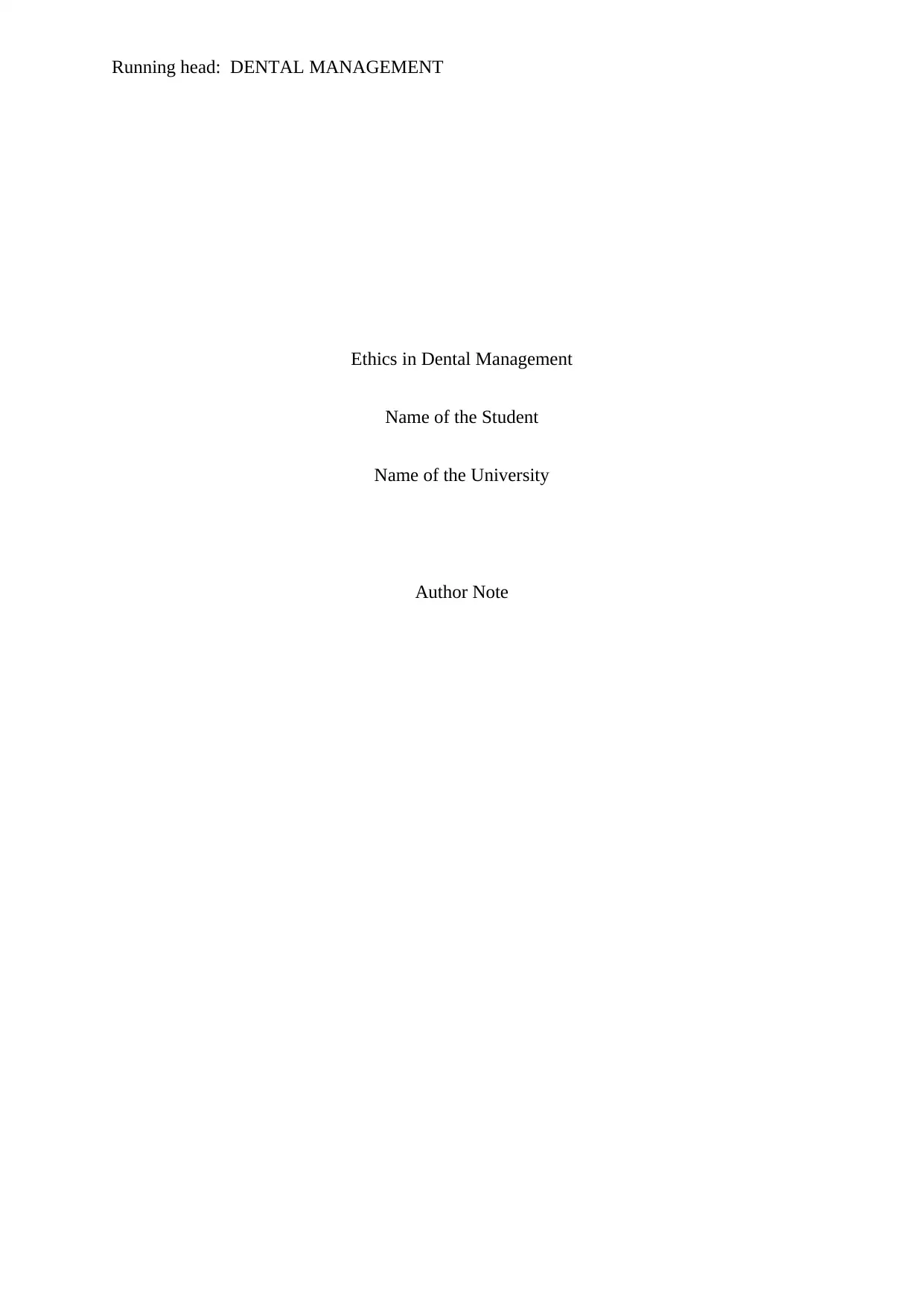
Running head: DENTAL MANAGEMENT
Ethics in Dental Management
Name of the Student
Name of the University
Author Note
Ethics in Dental Management
Name of the Student
Name of the University
Author Note
Paraphrase This Document
Need a fresh take? Get an instant paraphrase of this document with our AI Paraphraser
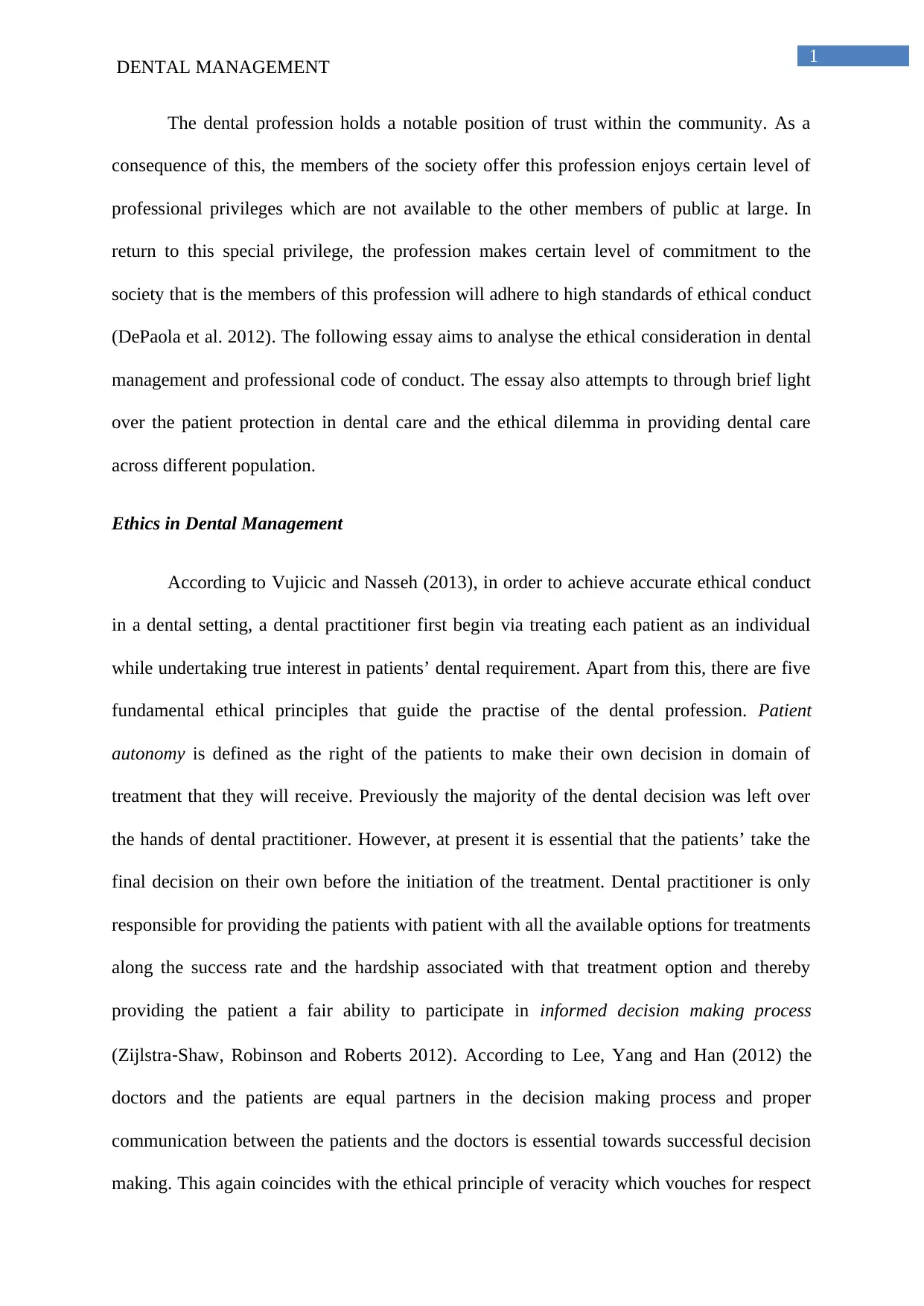
1
DENTAL MANAGEMENT
The dental profession holds a notable position of trust within the community. As a
consequence of this, the members of the society offer this profession enjoys certain level of
professional privileges which are not available to the other members of public at large. In
return to this special privilege, the profession makes certain level of commitment to the
society that is the members of this profession will adhere to high standards of ethical conduct
(DePaola et al. 2012). The following essay aims to analyse the ethical consideration in dental
management and professional code of conduct. The essay also attempts to through brief light
over the patient protection in dental care and the ethical dilemma in providing dental care
across different population.
Ethics in Dental Management
According to Vujicic and Nasseh (2013), in order to achieve accurate ethical conduct
in a dental setting, a dental practitioner first begin via treating each patient as an individual
while undertaking true interest in patients’ dental requirement. Apart from this, there are five
fundamental ethical principles that guide the practise of the dental profession. Patient
autonomy is defined as the right of the patients to make their own decision in domain of
treatment that they will receive. Previously the majority of the dental decision was left over
the hands of dental practitioner. However, at present it is essential that the patients’ take the
final decision on their own before the initiation of the treatment. Dental practitioner is only
responsible for providing the patients with patient with all the available options for treatments
along the success rate and the hardship associated with that treatment option and thereby
providing the patient a fair ability to participate in informed decision making process
(Zijlstra‐Shaw, Robinson and Roberts 2012). According to Lee, Yang and Han (2012) the
doctors and the patients are equal partners in the decision making process and proper
communication between the patients and the doctors is essential towards successful decision
making. This again coincides with the ethical principle of veracity which vouches for respect
DENTAL MANAGEMENT
The dental profession holds a notable position of trust within the community. As a
consequence of this, the members of the society offer this profession enjoys certain level of
professional privileges which are not available to the other members of public at large. In
return to this special privilege, the profession makes certain level of commitment to the
society that is the members of this profession will adhere to high standards of ethical conduct
(DePaola et al. 2012). The following essay aims to analyse the ethical consideration in dental
management and professional code of conduct. The essay also attempts to through brief light
over the patient protection in dental care and the ethical dilemma in providing dental care
across different population.
Ethics in Dental Management
According to Vujicic and Nasseh (2013), in order to achieve accurate ethical conduct
in a dental setting, a dental practitioner first begin via treating each patient as an individual
while undertaking true interest in patients’ dental requirement. Apart from this, there are five
fundamental ethical principles that guide the practise of the dental profession. Patient
autonomy is defined as the right of the patients to make their own decision in domain of
treatment that they will receive. Previously the majority of the dental decision was left over
the hands of dental practitioner. However, at present it is essential that the patients’ take the
final decision on their own before the initiation of the treatment. Dental practitioner is only
responsible for providing the patients with patient with all the available options for treatments
along the success rate and the hardship associated with that treatment option and thereby
providing the patient a fair ability to participate in informed decision making process
(Zijlstra‐Shaw, Robinson and Roberts 2012). According to Lee, Yang and Han (2012) the
doctors and the patients are equal partners in the decision making process and proper
communication between the patients and the doctors is essential towards successful decision
making. This again coincides with the ethical principle of veracity which vouches for respect
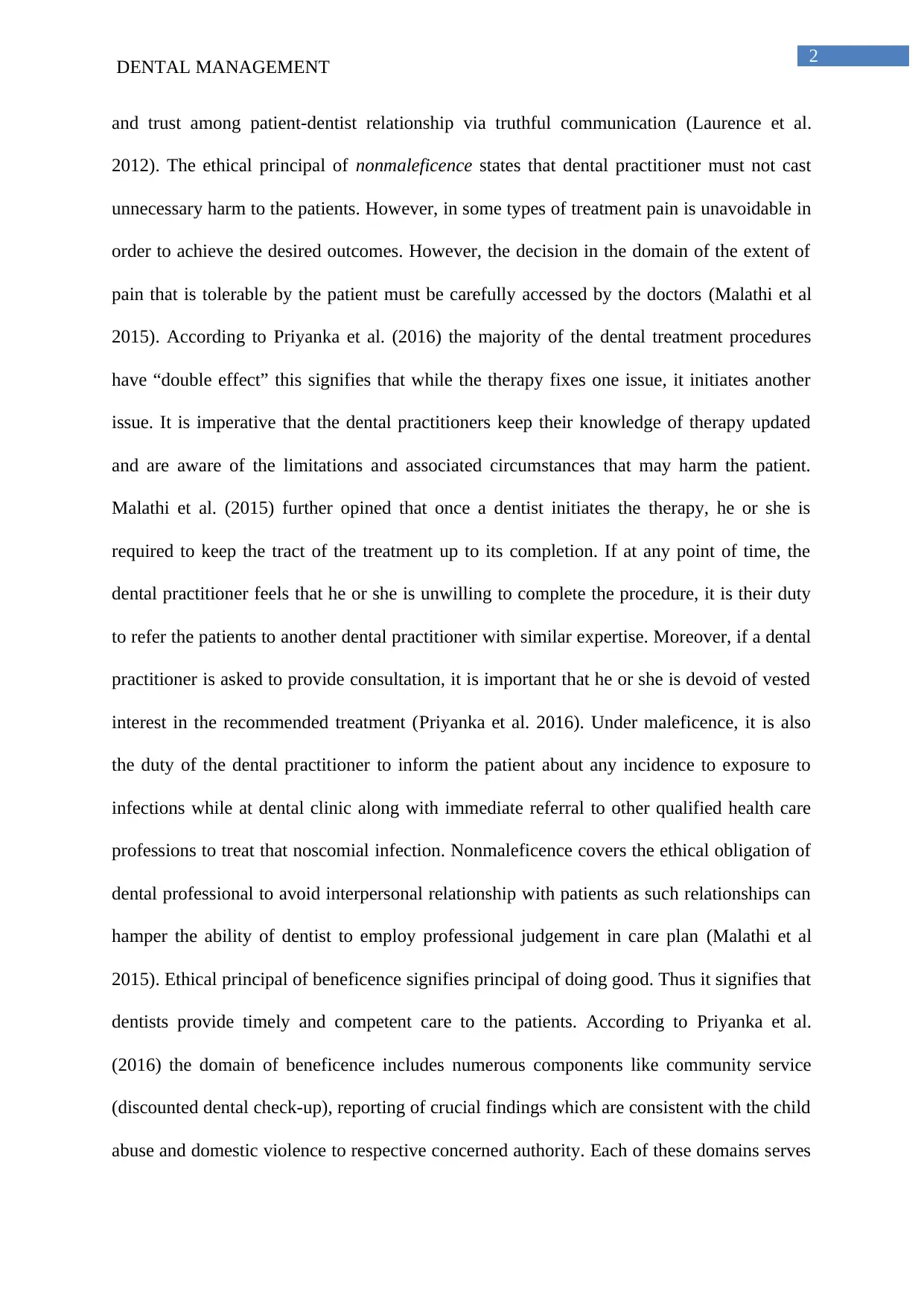
2
DENTAL MANAGEMENT
and trust among patient-dentist relationship via truthful communication (Laurence et al.
2012). The ethical principal of nonmaleficence states that dental practitioner must not cast
unnecessary harm to the patients. However, in some types of treatment pain is unavoidable in
order to achieve the desired outcomes. However, the decision in the domain of the extent of
pain that is tolerable by the patient must be carefully accessed by the doctors (Malathi et al
2015). According to Priyanka et al. (2016) the majority of the dental treatment procedures
have “double effect” this signifies that while the therapy fixes one issue, it initiates another
issue. It is imperative that the dental practitioners keep their knowledge of therapy updated
and are aware of the limitations and associated circumstances that may harm the patient.
Malathi et al. (2015) further opined that once a dentist initiates the therapy, he or she is
required to keep the tract of the treatment up to its completion. If at any point of time, the
dental practitioner feels that he or she is unwilling to complete the procedure, it is their duty
to refer the patients to another dental practitioner with similar expertise. Moreover, if a dental
practitioner is asked to provide consultation, it is important that he or she is devoid of vested
interest in the recommended treatment (Priyanka et al. 2016). Under maleficence, it is also
the duty of the dental practitioner to inform the patient about any incidence to exposure to
infections while at dental clinic along with immediate referral to other qualified health care
professions to treat that noscomial infection. Nonmaleficence covers the ethical obligation of
dental professional to avoid interpersonal relationship with patients as such relationships can
hamper the ability of dentist to employ professional judgement in care plan (Malathi et al
2015). Ethical principal of beneficence signifies principal of doing good. Thus it signifies that
dentists provide timely and competent care to the patients. According to Priyanka et al.
(2016) the domain of beneficence includes numerous components like community service
(discounted dental check-up), reporting of crucial findings which are consistent with the child
abuse and domestic violence to respective concerned authority. Each of these domains serves
DENTAL MANAGEMENT
and trust among patient-dentist relationship via truthful communication (Laurence et al.
2012). The ethical principal of nonmaleficence states that dental practitioner must not cast
unnecessary harm to the patients. However, in some types of treatment pain is unavoidable in
order to achieve the desired outcomes. However, the decision in the domain of the extent of
pain that is tolerable by the patient must be carefully accessed by the doctors (Malathi et al
2015). According to Priyanka et al. (2016) the majority of the dental treatment procedures
have “double effect” this signifies that while the therapy fixes one issue, it initiates another
issue. It is imperative that the dental practitioners keep their knowledge of therapy updated
and are aware of the limitations and associated circumstances that may harm the patient.
Malathi et al. (2015) further opined that once a dentist initiates the therapy, he or she is
required to keep the tract of the treatment up to its completion. If at any point of time, the
dental practitioner feels that he or she is unwilling to complete the procedure, it is their duty
to refer the patients to another dental practitioner with similar expertise. Moreover, if a dental
practitioner is asked to provide consultation, it is important that he or she is devoid of vested
interest in the recommended treatment (Priyanka et al. 2016). Under maleficence, it is also
the duty of the dental practitioner to inform the patient about any incidence to exposure to
infections while at dental clinic along with immediate referral to other qualified health care
professions to treat that noscomial infection. Nonmaleficence covers the ethical obligation of
dental professional to avoid interpersonal relationship with patients as such relationships can
hamper the ability of dentist to employ professional judgement in care plan (Malathi et al
2015). Ethical principal of beneficence signifies principal of doing good. Thus it signifies that
dentists provide timely and competent care to the patients. According to Priyanka et al.
(2016) the domain of beneficence includes numerous components like community service
(discounted dental check-up), reporting of crucial findings which are consistent with the child
abuse and domestic violence to respective concerned authority. Each of these domains serves
⊘ This is a preview!⊘
Do you want full access?
Subscribe today to unlock all pages.

Trusted by 1+ million students worldwide
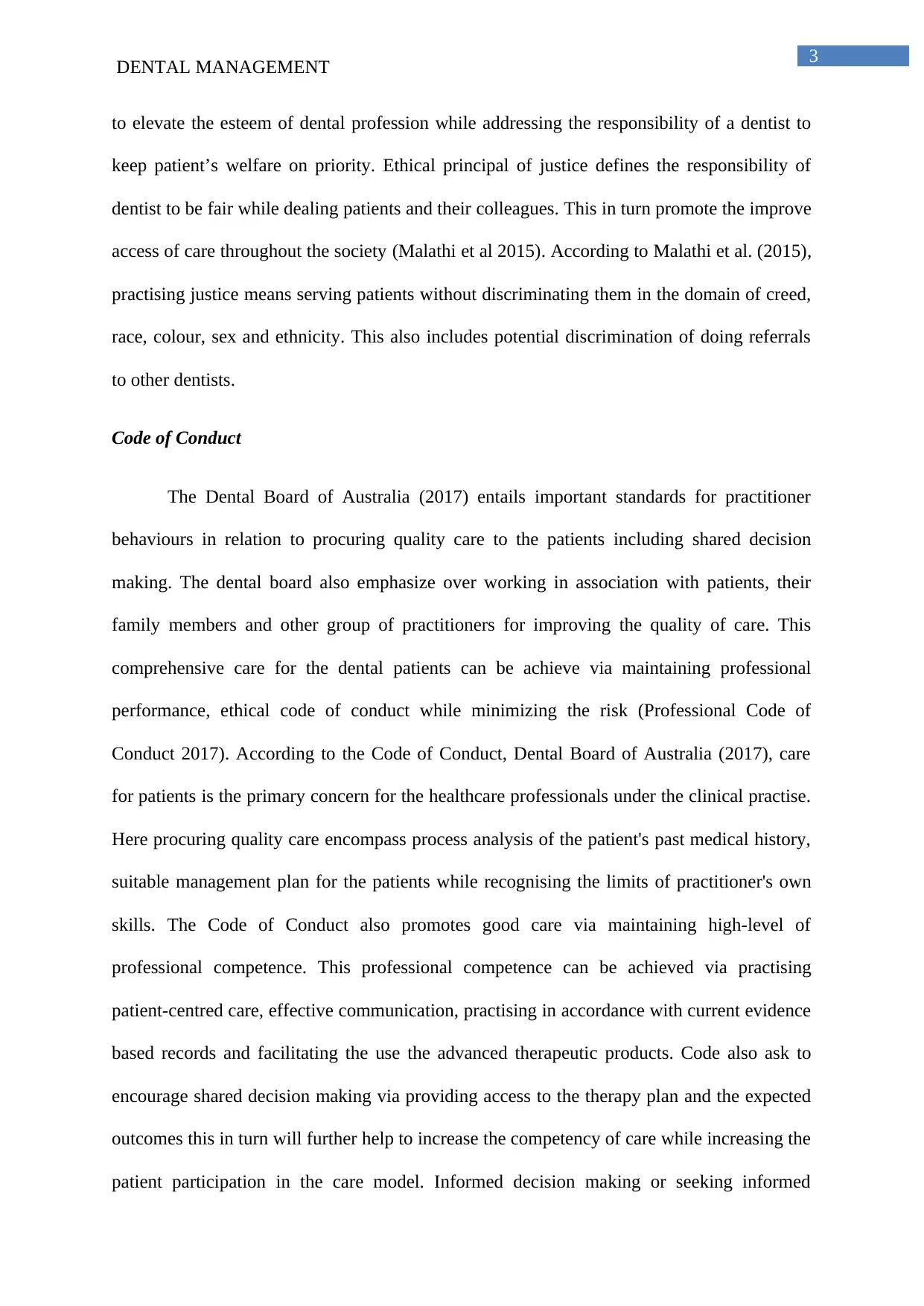
3
DENTAL MANAGEMENT
to elevate the esteem of dental profession while addressing the responsibility of a dentist to
keep patient’s welfare on priority. Ethical principal of justice defines the responsibility of
dentist to be fair while dealing patients and their colleagues. This in turn promote the improve
access of care throughout the society (Malathi et al 2015). According to Malathi et al. (2015),
practising justice means serving patients without discriminating them in the domain of creed,
race, colour, sex and ethnicity. This also includes potential discrimination of doing referrals
to other dentists.
Code of Conduct
The Dental Board of Australia (2017) entails important standards for practitioner
behaviours in relation to procuring quality care to the patients including shared decision
making. The dental board also emphasize over working in association with patients, their
family members and other group of practitioners for improving the quality of care. This
comprehensive care for the dental patients can be achieve via maintaining professional
performance, ethical code of conduct while minimizing the risk (Professional Code of
Conduct 2017). According to the Code of Conduct, Dental Board of Australia (2017), care
for patients is the primary concern for the healthcare professionals under the clinical practise.
Here procuring quality care encompass process analysis of the patient's past medical history,
suitable management plan for the patients while recognising the limits of practitioner's own
skills. The Code of Conduct also promotes good care via maintaining high-level of
professional competence. This professional competence can be achieved via practising
patient-centred care, effective communication, practising in accordance with current evidence
based records and facilitating the use the advanced therapeutic products. Code also ask to
encourage shared decision making via providing access to the therapy plan and the expected
outcomes this in turn will further help to increase the competency of care while increasing the
patient participation in the care model. Informed decision making or seeking informed
DENTAL MANAGEMENT
to elevate the esteem of dental profession while addressing the responsibility of a dentist to
keep patient’s welfare on priority. Ethical principal of justice defines the responsibility of
dentist to be fair while dealing patients and their colleagues. This in turn promote the improve
access of care throughout the society (Malathi et al 2015). According to Malathi et al. (2015),
practising justice means serving patients without discriminating them in the domain of creed,
race, colour, sex and ethnicity. This also includes potential discrimination of doing referrals
to other dentists.
Code of Conduct
The Dental Board of Australia (2017) entails important standards for practitioner
behaviours in relation to procuring quality care to the patients including shared decision
making. The dental board also emphasize over working in association with patients, their
family members and other group of practitioners for improving the quality of care. This
comprehensive care for the dental patients can be achieve via maintaining professional
performance, ethical code of conduct while minimizing the risk (Professional Code of
Conduct 2017). According to the Code of Conduct, Dental Board of Australia (2017), care
for patients is the primary concern for the healthcare professionals under the clinical practise.
Here procuring quality care encompass process analysis of the patient's past medical history,
suitable management plan for the patients while recognising the limits of practitioner's own
skills. The Code of Conduct also promotes good care via maintaining high-level of
professional competence. This professional competence can be achieved via practising
patient-centred care, effective communication, practising in accordance with current evidence
based records and facilitating the use the advanced therapeutic products. Code also ask to
encourage shared decision making via providing access to the therapy plan and the expected
outcomes this in turn will further help to increase the competency of care while increasing the
patient participation in the care model. Informed decision making or seeking informed
Paraphrase This Document
Need a fresh take? Get an instant paraphrase of this document with our AI Paraphraser
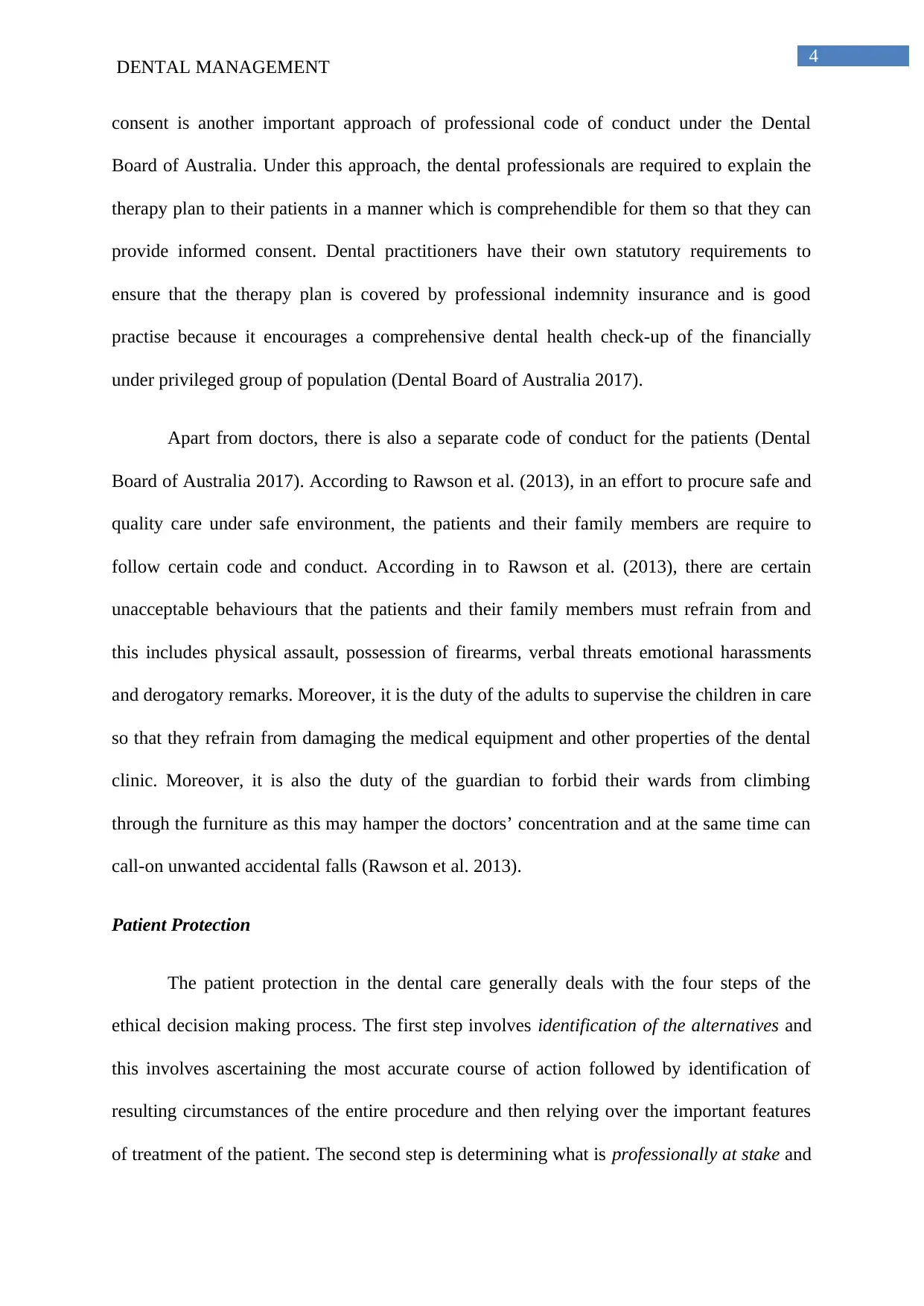
4
DENTAL MANAGEMENT
consent is another important approach of professional code of conduct under the Dental
Board of Australia. Under this approach, the dental professionals are required to explain the
therapy plan to their patients in a manner which is comprehendible for them so that they can
provide informed consent. Dental practitioners have their own statutory requirements to
ensure that the therapy plan is covered by professional indemnity insurance and is good
practise because it encourages a comprehensive dental health check-up of the financially
under privileged group of population (Dental Board of Australia 2017).
Apart from doctors, there is also a separate code of conduct for the patients (Dental
Board of Australia 2017). According to Rawson et al. (2013), in an effort to procure safe and
quality care under safe environment, the patients and their family members are require to
follow certain code and conduct. According in to Rawson et al. (2013), there are certain
unacceptable behaviours that the patients and their family members must refrain from and
this includes physical assault, possession of firearms, verbal threats emotional harassments
and derogatory remarks. Moreover, it is the duty of the adults to supervise the children in care
so that they refrain from damaging the medical equipment and other properties of the dental
clinic. Moreover, it is also the duty of the guardian to forbid their wards from climbing
through the furniture as this may hamper the doctors’ concentration and at the same time can
call-on unwanted accidental falls (Rawson et al. 2013).
Patient Protection
The patient protection in the dental care generally deals with the four steps of the
ethical decision making process. The first step involves identification of the alternatives and
this involves ascertaining the most accurate course of action followed by identification of
resulting circumstances of the entire procedure and then relying over the important features
of treatment of the patient. The second step is determining what is professionally at stake and
DENTAL MANAGEMENT
consent is another important approach of professional code of conduct under the Dental
Board of Australia. Under this approach, the dental professionals are required to explain the
therapy plan to their patients in a manner which is comprehendible for them so that they can
provide informed consent. Dental practitioners have their own statutory requirements to
ensure that the therapy plan is covered by professional indemnity insurance and is good
practise because it encourages a comprehensive dental health check-up of the financially
under privileged group of population (Dental Board of Australia 2017).
Apart from doctors, there is also a separate code of conduct for the patients (Dental
Board of Australia 2017). According to Rawson et al. (2013), in an effort to procure safe and
quality care under safe environment, the patients and their family members are require to
follow certain code and conduct. According in to Rawson et al. (2013), there are certain
unacceptable behaviours that the patients and their family members must refrain from and
this includes physical assault, possession of firearms, verbal threats emotional harassments
and derogatory remarks. Moreover, it is the duty of the adults to supervise the children in care
so that they refrain from damaging the medical equipment and other properties of the dental
clinic. Moreover, it is also the duty of the guardian to forbid their wards from climbing
through the furniture as this may hamper the doctors’ concentration and at the same time can
call-on unwanted accidental falls (Rawson et al. 2013).
Patient Protection
The patient protection in the dental care generally deals with the four steps of the
ethical decision making process. The first step involves identification of the alternatives and
this involves ascertaining the most accurate course of action followed by identification of
resulting circumstances of the entire procedure and then relying over the important features
of treatment of the patient. The second step is determining what is professionally at stake and
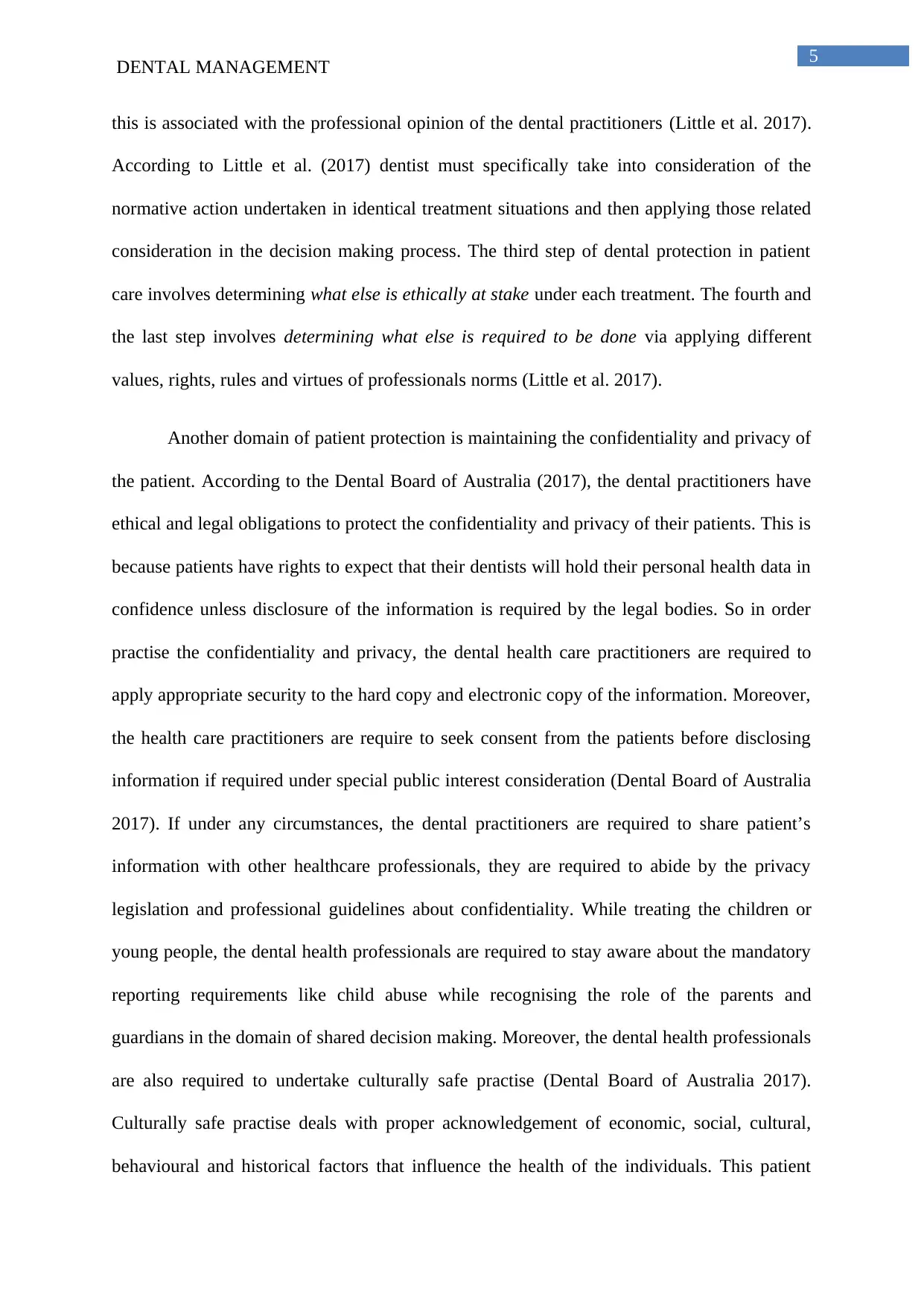
5
DENTAL MANAGEMENT
this is associated with the professional opinion of the dental practitioners (Little et al. 2017).
According to Little et al. (2017) dentist must specifically take into consideration of the
normative action undertaken in identical treatment situations and then applying those related
consideration in the decision making process. The third step of dental protection in patient
care involves determining what else is ethically at stake under each treatment. The fourth and
the last step involves determining what else is required to be done via applying different
values, rights, rules and virtues of professionals norms (Little et al. 2017).
Another domain of patient protection is maintaining the confidentiality and privacy of
the patient. According to the Dental Board of Australia (2017), the dental practitioners have
ethical and legal obligations to protect the confidentiality and privacy of their patients. This is
because patients have rights to expect that their dentists will hold their personal health data in
confidence unless disclosure of the information is required by the legal bodies. So in order
practise the confidentiality and privacy, the dental health care practitioners are required to
apply appropriate security to the hard copy and electronic copy of the information. Moreover,
the health care practitioners are require to seek consent from the patients before disclosing
information if required under special public interest consideration (Dental Board of Australia
2017). If under any circumstances, the dental practitioners are required to share patient’s
information with other healthcare professionals, they are required to abide by the privacy
legislation and professional guidelines about confidentiality. While treating the children or
young people, the dental health professionals are required to stay aware about the mandatory
reporting requirements like child abuse while recognising the role of the parents and
guardians in the domain of shared decision making. Moreover, the dental health professionals
are also required to undertake culturally safe practise (Dental Board of Australia 2017).
Culturally safe practise deals with proper acknowledgement of economic, social, cultural,
behavioural and historical factors that influence the health of the individuals. This patient
DENTAL MANAGEMENT
this is associated with the professional opinion of the dental practitioners (Little et al. 2017).
According to Little et al. (2017) dentist must specifically take into consideration of the
normative action undertaken in identical treatment situations and then applying those related
consideration in the decision making process. The third step of dental protection in patient
care involves determining what else is ethically at stake under each treatment. The fourth and
the last step involves determining what else is required to be done via applying different
values, rights, rules and virtues of professionals norms (Little et al. 2017).
Another domain of patient protection is maintaining the confidentiality and privacy of
the patient. According to the Dental Board of Australia (2017), the dental practitioners have
ethical and legal obligations to protect the confidentiality and privacy of their patients. This is
because patients have rights to expect that their dentists will hold their personal health data in
confidence unless disclosure of the information is required by the legal bodies. So in order
practise the confidentiality and privacy, the dental health care practitioners are required to
apply appropriate security to the hard copy and electronic copy of the information. Moreover,
the health care practitioners are require to seek consent from the patients before disclosing
information if required under special public interest consideration (Dental Board of Australia
2017). If under any circumstances, the dental practitioners are required to share patient’s
information with other healthcare professionals, they are required to abide by the privacy
legislation and professional guidelines about confidentiality. While treating the children or
young people, the dental health professionals are required to stay aware about the mandatory
reporting requirements like child abuse while recognising the role of the parents and
guardians in the domain of shared decision making. Moreover, the dental health professionals
are also required to undertake culturally safe practise (Dental Board of Australia 2017).
Culturally safe practise deals with proper acknowledgement of economic, social, cultural,
behavioural and historical factors that influence the health of the individuals. This patient
⊘ This is a preview!⊘
Do you want full access?
Subscribe today to unlock all pages.

Trusted by 1+ million students worldwide
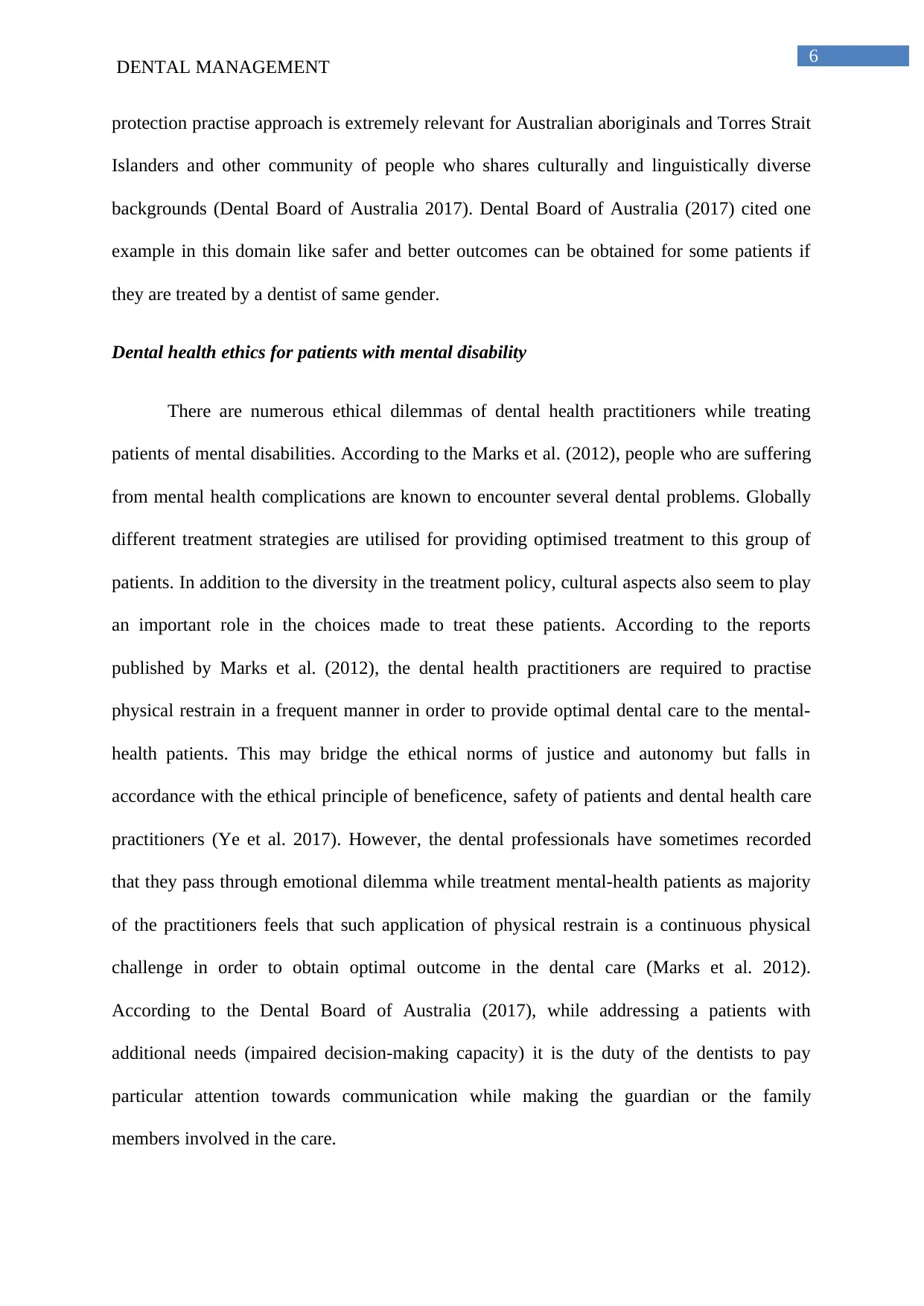
6
DENTAL MANAGEMENT
protection practise approach is extremely relevant for Australian aboriginals and Torres Strait
Islanders and other community of people who shares culturally and linguistically diverse
backgrounds (Dental Board of Australia 2017). Dental Board of Australia (2017) cited one
example in this domain like safer and better outcomes can be obtained for some patients if
they are treated by a dentist of same gender.
Dental health ethics for patients with mental disability
There are numerous ethical dilemmas of dental health practitioners while treating
patients of mental disabilities. According to the Marks et al. (2012), people who are suffering
from mental health complications are known to encounter several dental problems. Globally
different treatment strategies are utilised for providing optimised treatment to this group of
patients. In addition to the diversity in the treatment policy, cultural aspects also seem to play
an important role in the choices made to treat these patients. According to the reports
published by Marks et al. (2012), the dental health practitioners are required to practise
physical restrain in a frequent manner in order to provide optimal dental care to the mental-
health patients. This may bridge the ethical norms of justice and autonomy but falls in
accordance with the ethical principle of beneficence, safety of patients and dental health care
practitioners (Ye et al. 2017). However, the dental professionals have sometimes recorded
that they pass through emotional dilemma while treatment mental-health patients as majority
of the practitioners feels that such application of physical restrain is a continuous physical
challenge in order to obtain optimal outcome in the dental care (Marks et al. 2012).
According to the Dental Board of Australia (2017), while addressing a patients with
additional needs (impaired decision-making capacity) it is the duty of the dentists to pay
particular attention towards communication while making the guardian or the family
members involved in the care.
DENTAL MANAGEMENT
protection practise approach is extremely relevant for Australian aboriginals and Torres Strait
Islanders and other community of people who shares culturally and linguistically diverse
backgrounds (Dental Board of Australia 2017). Dental Board of Australia (2017) cited one
example in this domain like safer and better outcomes can be obtained for some patients if
they are treated by a dentist of same gender.
Dental health ethics for patients with mental disability
There are numerous ethical dilemmas of dental health practitioners while treating
patients of mental disabilities. According to the Marks et al. (2012), people who are suffering
from mental health complications are known to encounter several dental problems. Globally
different treatment strategies are utilised for providing optimised treatment to this group of
patients. In addition to the diversity in the treatment policy, cultural aspects also seem to play
an important role in the choices made to treat these patients. According to the reports
published by Marks et al. (2012), the dental health practitioners are required to practise
physical restrain in a frequent manner in order to provide optimal dental care to the mental-
health patients. This may bridge the ethical norms of justice and autonomy but falls in
accordance with the ethical principle of beneficence, safety of patients and dental health care
practitioners (Ye et al. 2017). However, the dental professionals have sometimes recorded
that they pass through emotional dilemma while treatment mental-health patients as majority
of the practitioners feels that such application of physical restrain is a continuous physical
challenge in order to obtain optimal outcome in the dental care (Marks et al. 2012).
According to the Dental Board of Australia (2017), while addressing a patients with
additional needs (impaired decision-making capacity) it is the duty of the dentists to pay
particular attention towards communication while making the guardian or the family
members involved in the care.
Paraphrase This Document
Need a fresh take? Get an instant paraphrase of this document with our AI Paraphraser
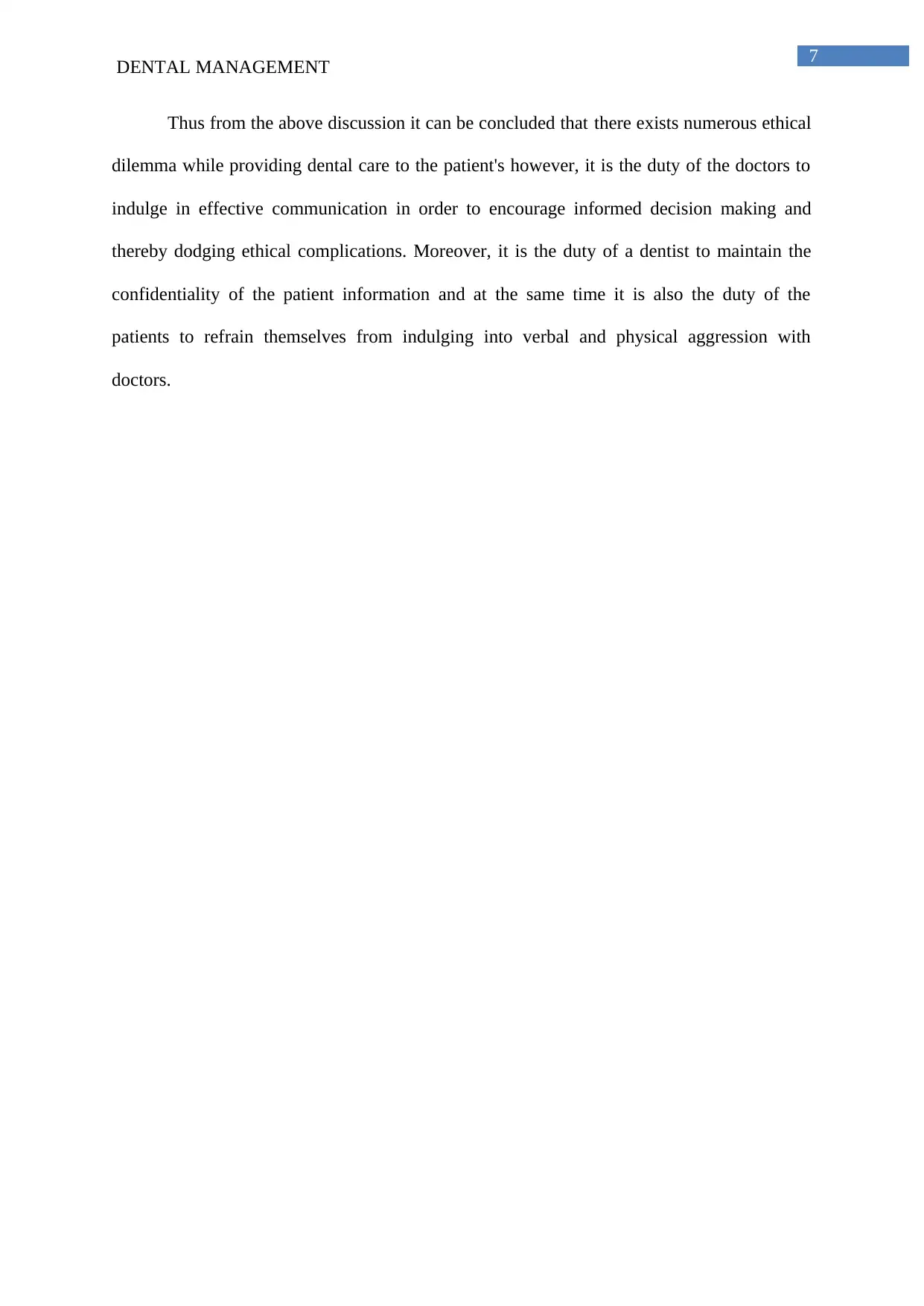
7
DENTAL MANAGEMENT
Thus from the above discussion it can be concluded that there exists numerous ethical
dilemma while providing dental care to the patient's however, it is the duty of the doctors to
indulge in effective communication in order to encourage informed decision making and
thereby dodging ethical complications. Moreover, it is the duty of a dentist to maintain the
confidentiality of the patient information and at the same time it is also the duty of the
patients to refrain themselves from indulging into verbal and physical aggression with
doctors.
DENTAL MANAGEMENT
Thus from the above discussion it can be concluded that there exists numerous ethical
dilemma while providing dental care to the patient's however, it is the duty of the doctors to
indulge in effective communication in order to encourage informed decision making and
thereby dodging ethical complications. Moreover, it is the duty of a dentist to maintain the
confidentiality of the patient information and at the same time it is also the duty of the
patients to refrain themselves from indulging into verbal and physical aggression with
doctors.
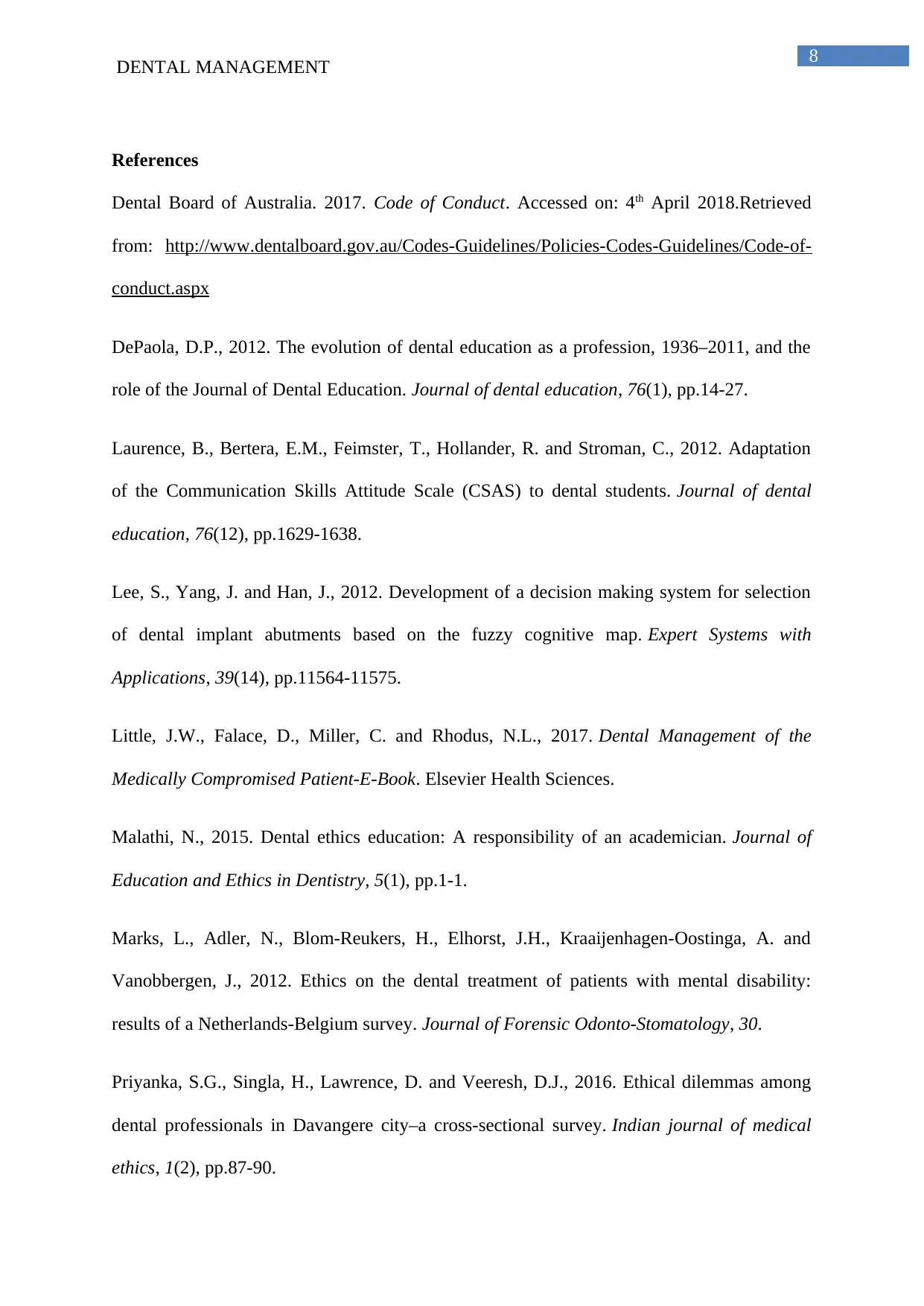
8
DENTAL MANAGEMENT
References
Dental Board of Australia. 2017. Code of Conduct. Accessed on: 4th April 2018.Retrieved
from: http://www.dentalboard.gov.au/Codes-Guidelines/Policies-Codes-Guidelines/Code-of-
conduct.aspx
DePaola, D.P., 2012. The evolution of dental education as a profession, 1936–2011, and the
role of the Journal of Dental Education. Journal of dental education, 76(1), pp.14-27.
Laurence, B., Bertera, E.M., Feimster, T., Hollander, R. and Stroman, C., 2012. Adaptation
of the Communication Skills Attitude Scale (CSAS) to dental students. Journal of dental
education, 76(12), pp.1629-1638.
Lee, S., Yang, J. and Han, J., 2012. Development of a decision making system for selection
of dental implant abutments based on the fuzzy cognitive map. Expert Systems with
Applications, 39(14), pp.11564-11575.
Little, J.W., Falace, D., Miller, C. and Rhodus, N.L., 2017. Dental Management of the
Medically Compromised Patient-E-Book. Elsevier Health Sciences.
Malathi, N., 2015. Dental ethics education: A responsibility of an academician. Journal of
Education and Ethics in Dentistry, 5(1), pp.1-1.
Marks, L., Adler, N., Blom-Reukers, H., Elhorst, J.H., Kraaijenhagen-Oostinga, A. and
Vanobbergen, J., 2012. Ethics on the dental treatment of patients with mental disability:
results of a Netherlands-Belgium survey. Journal of Forensic Odonto-Stomatology, 30.
Priyanka, S.G., Singla, H., Lawrence, D. and Veeresh, D.J., 2016. Ethical dilemmas among
dental professionals in Davangere city–a cross-sectional survey. Indian journal of medical
ethics, 1(2), pp.87-90.
DENTAL MANAGEMENT
References
Dental Board of Australia. 2017. Code of Conduct. Accessed on: 4th April 2018.Retrieved
from: http://www.dentalboard.gov.au/Codes-Guidelines/Policies-Codes-Guidelines/Code-of-
conduct.aspx
DePaola, D.P., 2012. The evolution of dental education as a profession, 1936–2011, and the
role of the Journal of Dental Education. Journal of dental education, 76(1), pp.14-27.
Laurence, B., Bertera, E.M., Feimster, T., Hollander, R. and Stroman, C., 2012. Adaptation
of the Communication Skills Attitude Scale (CSAS) to dental students. Journal of dental
education, 76(12), pp.1629-1638.
Lee, S., Yang, J. and Han, J., 2012. Development of a decision making system for selection
of dental implant abutments based on the fuzzy cognitive map. Expert Systems with
Applications, 39(14), pp.11564-11575.
Little, J.W., Falace, D., Miller, C. and Rhodus, N.L., 2017. Dental Management of the
Medically Compromised Patient-E-Book. Elsevier Health Sciences.
Malathi, N., 2015. Dental ethics education: A responsibility of an academician. Journal of
Education and Ethics in Dentistry, 5(1), pp.1-1.
Marks, L., Adler, N., Blom-Reukers, H., Elhorst, J.H., Kraaijenhagen-Oostinga, A. and
Vanobbergen, J., 2012. Ethics on the dental treatment of patients with mental disability:
results of a Netherlands-Belgium survey. Journal of Forensic Odonto-Stomatology, 30.
Priyanka, S.G., Singla, H., Lawrence, D. and Veeresh, D.J., 2016. Ethical dilemmas among
dental professionals in Davangere city–a cross-sectional survey. Indian journal of medical
ethics, 1(2), pp.87-90.
⊘ This is a preview!⊘
Do you want full access?
Subscribe today to unlock all pages.

Trusted by 1+ million students worldwide
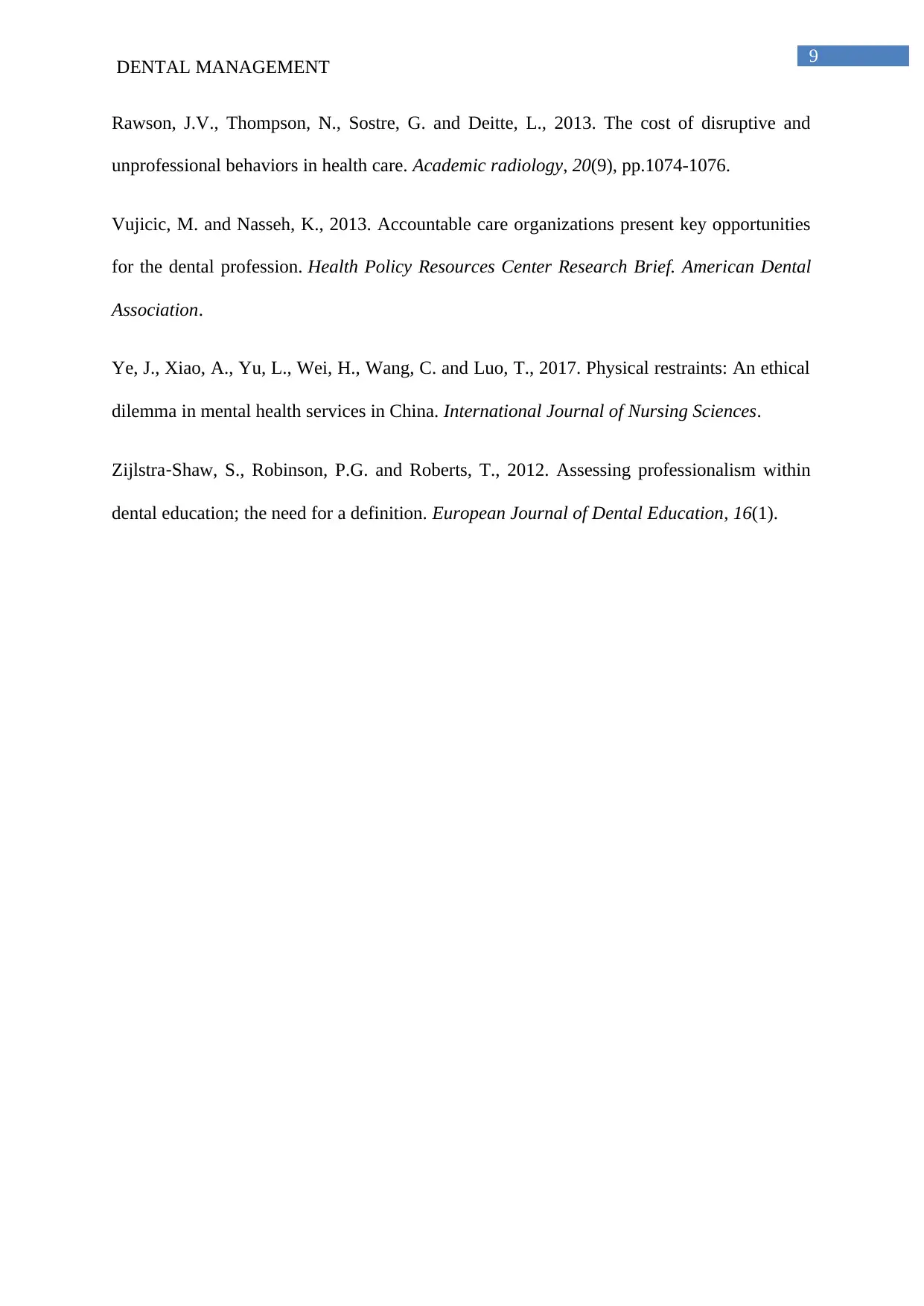
9
DENTAL MANAGEMENT
Rawson, J.V., Thompson, N., Sostre, G. and Deitte, L., 2013. The cost of disruptive and
unprofessional behaviors in health care. Academic radiology, 20(9), pp.1074-1076.
Vujicic, M. and Nasseh, K., 2013. Accountable care organizations present key opportunities
for the dental profession. Health Policy Resources Center Research Brief. American Dental
Association.
Ye, J., Xiao, A., Yu, L., Wei, H., Wang, C. and Luo, T., 2017. Physical restraints: An ethical
dilemma in mental health services in China. International Journal of Nursing Sciences.
Zijlstra‐Shaw, S., Robinson, P.G. and Roberts, T., 2012. Assessing professionalism within
dental education; the need for a definition. European Journal of Dental Education, 16(1).
DENTAL MANAGEMENT
Rawson, J.V., Thompson, N., Sostre, G. and Deitte, L., 2013. The cost of disruptive and
unprofessional behaviors in health care. Academic radiology, 20(9), pp.1074-1076.
Vujicic, M. and Nasseh, K., 2013. Accountable care organizations present key opportunities
for the dental profession. Health Policy Resources Center Research Brief. American Dental
Association.
Ye, J., Xiao, A., Yu, L., Wei, H., Wang, C. and Luo, T., 2017. Physical restraints: An ethical
dilemma in mental health services in China. International Journal of Nursing Sciences.
Zijlstra‐Shaw, S., Robinson, P.G. and Roberts, T., 2012. Assessing professionalism within
dental education; the need for a definition. European Journal of Dental Education, 16(1).
1 out of 10
Related Documents
Your All-in-One AI-Powered Toolkit for Academic Success.
+13062052269
info@desklib.com
Available 24*7 on WhatsApp / Email
![[object Object]](/_next/static/media/star-bottom.7253800d.svg)
Unlock your academic potential
© 2024 | Zucol Services PVT LTD | All rights reserved.





